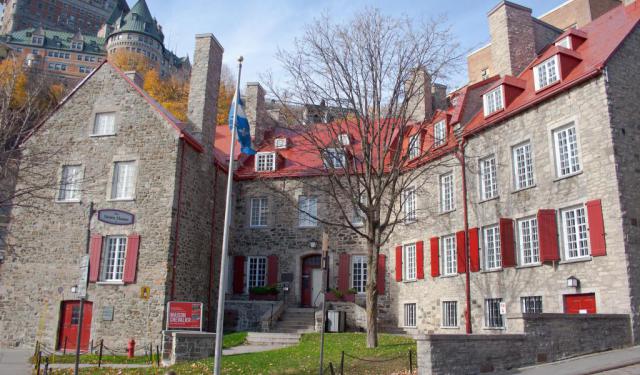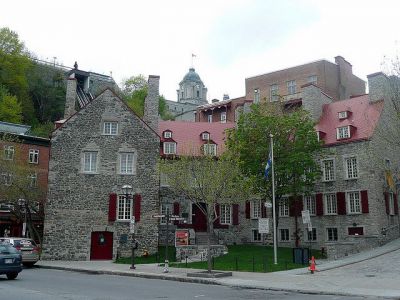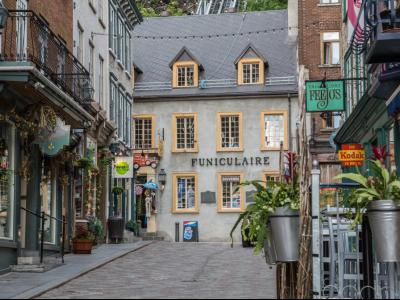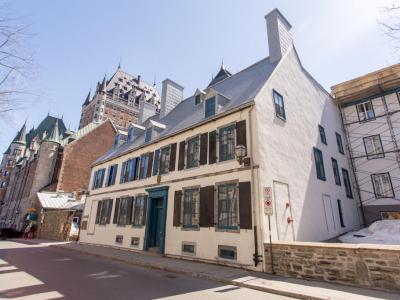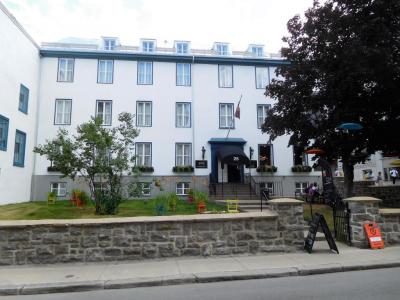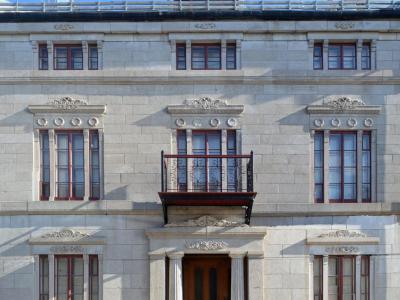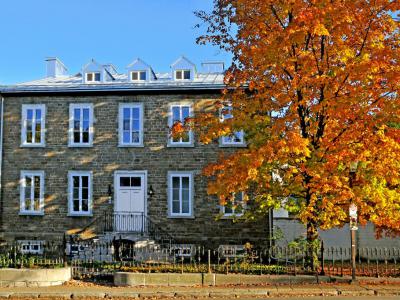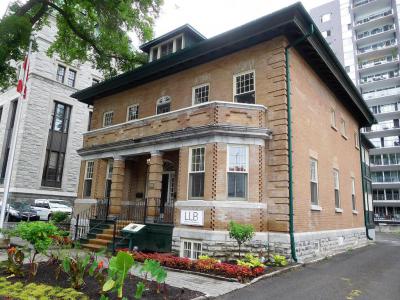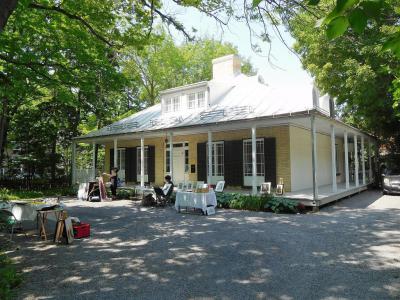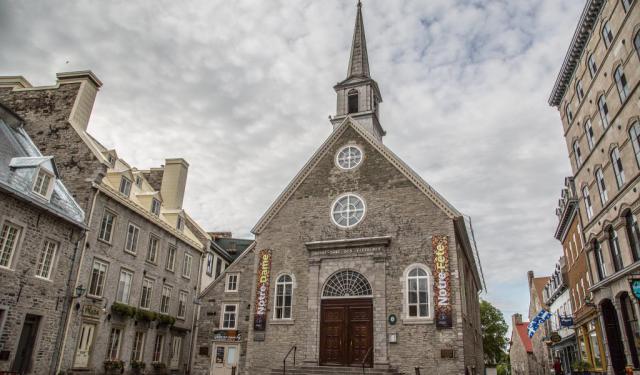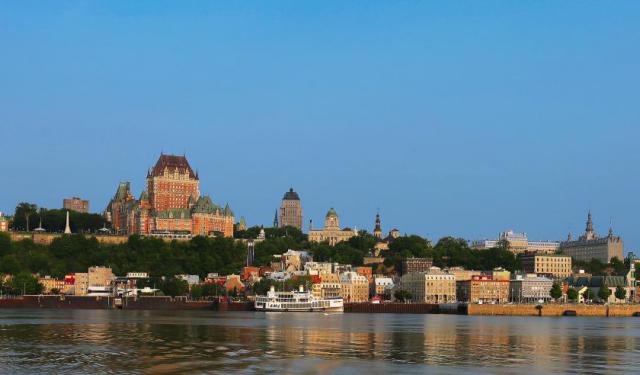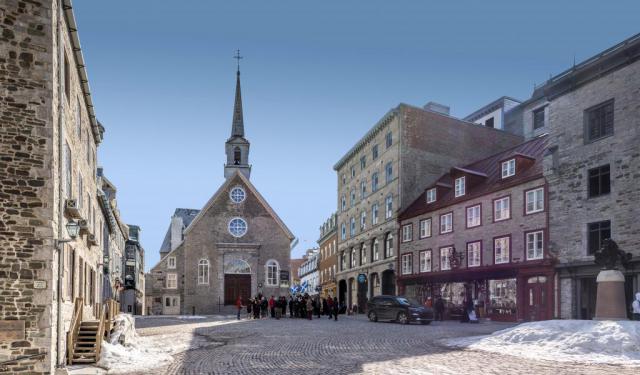Historical Houses Walking Tour (Self Guided), Quebec City
Quebec City, particularly evocative of Europe in its atmosphere, is often referred to as the cradle of New France. The city boasts one of the richest architectural heritages in North America, though most of its buildings had to be adapted to harsh winters and the lack of specialized workers and materials in the colony. As such, the majority of local houses were designed as simple and efficient before anything else.
While not overly extravagant, the more developed buildings on this tour stand out among the rest and will give you a wonderful glimpse into the lives of several pioneers of Canadian civilization.
The Chevalier House (Maison Chevalier) is a well-preserved example of French colonial architecture that serves as a gateway to Quebec's past. Nearby, the Louis Jolliet House (Maison Louis Jolliet) commemorates the famous explorer and cartographer who once lived here.
The Maillou House (Maison Maillou) is an architectural gem, showcasing a blend of French and British influences, reflecting Quebec City's history as a hub of cultural exchange. The Duke of Kent House (Maison Kent) is an elegant residence with a royal connection, having once housed Prince Edward, the Duke of Kent.
The Tetu House (Maison Tetu) and the Sewell House (Maison Sewell) transport visitors to the 19th century with their well-preserved interiors and captivating stories of the people who resided there. Meanwhile, the Louis Stephen Saint Laurent Heritage House pays tribute to Canada's 12th Prime Minister, offering insights into his life and times.
The Henry-Stuart House National Historic Site is a symbol of Quebec City's commitment to preserving its architectural and cultural heritage. This site, along with the others, invites visitors to step back in time and connect with the city's history.
As you explore these landmarks, you'll not only gain a deeper understanding of Quebec's past but also appreciate the architectural and cultural diversity that has shaped the city. So, don't miss the chance to take a close look at these historical buildings and discover the captivating stories they hold.
While not overly extravagant, the more developed buildings on this tour stand out among the rest and will give you a wonderful glimpse into the lives of several pioneers of Canadian civilization.
The Chevalier House (Maison Chevalier) is a well-preserved example of French colonial architecture that serves as a gateway to Quebec's past. Nearby, the Louis Jolliet House (Maison Louis Jolliet) commemorates the famous explorer and cartographer who once lived here.
The Maillou House (Maison Maillou) is an architectural gem, showcasing a blend of French and British influences, reflecting Quebec City's history as a hub of cultural exchange. The Duke of Kent House (Maison Kent) is an elegant residence with a royal connection, having once housed Prince Edward, the Duke of Kent.
The Tetu House (Maison Tetu) and the Sewell House (Maison Sewell) transport visitors to the 19th century with their well-preserved interiors and captivating stories of the people who resided there. Meanwhile, the Louis Stephen Saint Laurent Heritage House pays tribute to Canada's 12th Prime Minister, offering insights into his life and times.
The Henry-Stuart House National Historic Site is a symbol of Quebec City's commitment to preserving its architectural and cultural heritage. This site, along with the others, invites visitors to step back in time and connect with the city's history.
As you explore these landmarks, you'll not only gain a deeper understanding of Quebec's past but also appreciate the architectural and cultural diversity that has shaped the city. So, don't miss the chance to take a close look at these historical buildings and discover the captivating stories they hold.
How it works: Download the app "GPSmyCity: Walks in 1K+ Cities" from Apple App Store or Google Play Store to your mobile phone or tablet. The app turns your mobile device into a personal tour guide and its built-in GPS navigation functions guide you from one tour stop to next. The app works offline, so no data plan is needed when traveling abroad.
Historical Houses Walking Tour Map
Guide Name: Historical Houses Walking Tour
Guide Location: Canada » Quebec City (See other walking tours in Quebec City)
Guide Type: Self-guided Walking Tour (Sightseeing)
# of Attractions: 8
Tour Duration: 2 Hour(s)
Travel Distance: 2.5 Km or 1.6 Miles
Author: susan
Sight(s) Featured in This Guide:
Guide Location: Canada » Quebec City (See other walking tours in Quebec City)
Guide Type: Self-guided Walking Tour (Sightseeing)
# of Attractions: 8
Tour Duration: 2 Hour(s)
Travel Distance: 2.5 Km or 1.6 Miles
Author: susan
Sight(s) Featured in This Guide:
- Chevalier House (Maison Chevalier)
- Louis Jolliet House (Maison Louis Jolliet)
- Maillou House (Maison Maillou)
- Duke of Kent House (Maison Kent)
- Tetu House (Maison Tetu)
- Sewell House (Maison Sewell)
- Louis S. St. Laurent Heritage House
- Henry-Stuart House National Historic Site
1) Chevalier House (Maison Chevalier)
The Chevalier House (Maison Historique Chevalier) is a prominent example of French urban architecture in New France. This historical structure is composed of three distinct buildings from different time periods.
In the center stands the former residence of shipowner Jean-Baptiste Chevalier, constructed in 1752, which is closely connected to the neighboring mansard-style Frérot House, dating back to either 1683 or 1695. Additionally, the Chesnay House, dating back to 1660 or 1675, completes the trio.
All three houses suffered destruction by fire but were subsequently rebuilt in 1762. Following the British conquest of the region, the entire complex underwent partial renovations and was repurposed for commercial use. Starting in 1807, the property was leased to an innkeeper who named it the London Coffee House, a name that persisted until the early 20th century.
In the 1950s, these buildings narrowly avoided demolition when the government of Quebec acquired them as part of a significant restoration effort in the Royal Square area. Subsequently, in 1965, the complex received recognition as a historic monument and was transformed into a museum.
Set against the backdrop of Frontenac Castle, the Chevalier House offers an excellent photo opportunity for architecture enthusiasts, reflecting a substantial portion of the area's historical legacy. During the Quebec Carnival in February, it frequently hosts traditional music events.
In the center stands the former residence of shipowner Jean-Baptiste Chevalier, constructed in 1752, which is closely connected to the neighboring mansard-style Frérot House, dating back to either 1683 or 1695. Additionally, the Chesnay House, dating back to 1660 or 1675, completes the trio.
All three houses suffered destruction by fire but were subsequently rebuilt in 1762. Following the British conquest of the region, the entire complex underwent partial renovations and was repurposed for commercial use. Starting in 1807, the property was leased to an innkeeper who named it the London Coffee House, a name that persisted until the early 20th century.
In the 1950s, these buildings narrowly avoided demolition when the government of Quebec acquired them as part of a significant restoration effort in the Royal Square area. Subsequently, in 1965, the complex received recognition as a historic monument and was transformed into a museum.
Set against the backdrop of Frontenac Castle, the Chevalier House offers an excellent photo opportunity for architecture enthusiasts, reflecting a substantial portion of the area's historical legacy. During the Quebec Carnival in February, it frequently hosts traditional music events.
2) Louis Jolliet House (Maison Louis Jolliet)
The historic Louis Jolliet House, at 16 Petit-Champlain Street, today serves as the main entrance to the Old Quebec funicular. Designed by architect Claude Baillif, this was one of the earliest residences in Old Quebec built a year after the great fire of 1682.
The fire, which had almost completely razed the Lower Town, eventually prompted the authorities to require that all buildings be made of stone and fitted with firewalls. Among other things, this decision resulted in the spread of the first suburbs outside the city walls since poorer settlers could not meet the new costly requirements and were thus forced to move out.
The owner of the house, Louis Jolliet, an explorer, cartographer and hydrographer, lived here until his death in 1700. He was the first Quebec-born Canadian to make history. During one of his expeditions, Jolliet discovered and mapped the Mississippi River, being the first person of European parentage to accomplish such a feat.
Heavily damaged during the British Conquest and by a number of fires that happened later on, the house underwent several transformations that have reduced its state of authenticity. Nonetheless, some of its original features, attributing to the urban architecture of the French Colonial period, have survived.
The commanding location – at the top of Sous-le-Fort street – gives this property a privileged place in the urban landscape and, together with the access to the funicular, adds more value to it in the eyes of multiple visitors. As of 1985, the building has been an integral part of the Old Quebec UNESCO World Heritage Site.
The fire, which had almost completely razed the Lower Town, eventually prompted the authorities to require that all buildings be made of stone and fitted with firewalls. Among other things, this decision resulted in the spread of the first suburbs outside the city walls since poorer settlers could not meet the new costly requirements and were thus forced to move out.
The owner of the house, Louis Jolliet, an explorer, cartographer and hydrographer, lived here until his death in 1700. He was the first Quebec-born Canadian to make history. During one of his expeditions, Jolliet discovered and mapped the Mississippi River, being the first person of European parentage to accomplish such a feat.
Heavily damaged during the British Conquest and by a number of fires that happened later on, the house underwent several transformations that have reduced its state of authenticity. Nonetheless, some of its original features, attributing to the urban architecture of the French Colonial period, have survived.
The commanding location – at the top of Sous-le-Fort street – gives this property a privileged place in the urban landscape and, together with the access to the funicular, adds more value to it in the eyes of multiple visitors. As of 1985, the building has been an integral part of the Old Quebec UNESCO World Heritage Site.
3) Maillou House (Maison Maillou)
Located at 17 Saint-Louis Street in the historic district of Old Québec, this building was built around 1737 by Jean-Baptiste Maillou – one of the French regime's most prominent landowners and masonry contractors. It took on the appearance we know today after an upper storey was added in 1767 and an extension was built in 1799.
In 1815, the residence became the property of the British Army. During this period, it housed the commissariat and treasury, and accommodated senior officers until the troops left in 1871. After that time, the federal government took possession of the building, which notably became the headquarters for the militia and army for almost 60 years. Note the metal shutters used to thwart weather and unfriendly fire.
While access to the site is restricted, the courtyard and the outbuildings, where a restaurant is located, are accessible to the general public. A pamphlet and commemorative plaque provide the houses' history.
In 1815, the residence became the property of the British Army. During this period, it housed the commissariat and treasury, and accommodated senior officers until the troops left in 1871. After that time, the federal government took possession of the building, which notably became the headquarters for the militia and army for almost 60 years. Note the metal shutters used to thwart weather and unfriendly fire.
While access to the site is restricted, the courtyard and the outbuildings, where a restaurant is located, are accessible to the general public. A pamphlet and commemorative plaque provide the houses' history.
4) Duke of Kent House (Maison Kent)
Duke of Kent House (Maison Kent) stands at the intersection of the Saint-Louis Street and Haldimand, tucked behind the renowned Château Frontenac in Quebec City. It owes its name to Prince Edward, Duke of Kent and Strathearn, one of its notable residents. Despite undergoing various alterations over the years, a significant portion of its foundations and the first-floor walls harken back to around 1650, rendering it one of Quebec City's oldest, if not the oldest, dwellings. In 1759, the Articles of Capitulation of Quebec were signed within its walls, marking a pivotal moment in its history. Since 1819, the building has seen minimal structural changes and, from 1980 to 2015, it served as the French Consulate.
Constructed towards the close of the 17th century by the Chartier de Lotbinière family, Kent House is an integral part of the city's historical heritage. Its significance extends beyond its venerable architecture, encompassing the rich history of the numerous individuals who inhabited it over the years. Across generations, approximately thirty historical figures have played a role in shaping the history of both the city and the province of Quebec, contributing to the evolution of French-Canadian society through debates and struggles. This site, steeped in historical memory, has consistently served as a link between Quebec and France throughout its existence.
Designated as a Historic Monument by the Government of Quebec since 1952, it holds a pivotal place in the Old Quebec district, which has been recognized as a UNESCO World Heritage Site since 1985.
Constructed towards the close of the 17th century by the Chartier de Lotbinière family, Kent House is an integral part of the city's historical heritage. Its significance extends beyond its venerable architecture, encompassing the rich history of the numerous individuals who inhabited it over the years. Across generations, approximately thirty historical figures have played a role in shaping the history of both the city and the province of Quebec, contributing to the evolution of French-Canadian society through debates and struggles. This site, steeped in historical memory, has consistently served as a link between Quebec and France throughout its existence.
Designated as a Historic Monument by the Government of Quebec since 1952, it holds a pivotal place in the Old Quebec district, which has been recognized as a UNESCO World Heritage Site since 1985.
5) Tetu House (Maison Tetu)
The Maison Têtu is a particularly elaborate example of the many large, urban town houses built for prosperous Canadian merchants during the mid-19th century. It was designed in 1852 by Charles Baillairgé, a member of a celebrated family of architects who, beginning in the 18th century, left an important mark on the architecture of Québec City and its surroundings.
The house's Greek Revival facade, a masterpiece of the genre, is tastefully decorated with palmettes and discreet laurel wreaths. The main floor has huge bay windows that open onto a single expansive living room in the London style. From the time of its construction, the house incorporated all the modern amenities: central heating, hot running water and multiple bathrooms. Antoine de Saint-Exupéry, author of "The Little Prince", was hosted here by the De Koninck family in the early 1940s.
The house's Greek Revival facade, a masterpiece of the genre, is tastefully decorated with palmettes and discreet laurel wreaths. The main floor has huge bay windows that open onto a single expansive living room in the London style. From the time of its construction, the house incorporated all the modern amenities: central heating, hot running water and multiple bathrooms. Antoine de Saint-Exupéry, author of "The Little Prince", was hosted here by the De Koninck family in the early 1940s.
6) Sewell House (Maison Sewell)
Built in 1803-1804 and inspired by British Classicism, the Jonathan Sewell House illustrates early 19th-century development in Québec's upper middle-class settlement of Upper Town. The original owner, a lawyer, was appointed Solicitor General and Attorney General of Lower Canada before becoming Chief Justice and Chairman of the Executive Council in 1808. The Sewells had 16 children who were educated here, but the home was also known for hosting political debates.
In the early decades of the 19th century, the construction of dwellings for Anglophone elites introduced a new architectural vocabulary that included neoclassical elements such as symmetrical openings, low-pitched roofs, and a restrained appearance. The Sewell House's architectural character, as well as its well-crafted ashlar masonry construction, mirrors the penchant for British classical design so evident in nearby military buildings.
The property's official recognition also refers to the adjoining buildings, including the Saint-Louis barracks at the rear, and the Squash Ball Court, former workshop, garages and warehouse, built in different eras along the property's west border.
In the early decades of the 19th century, the construction of dwellings for Anglophone elites introduced a new architectural vocabulary that included neoclassical elements such as symmetrical openings, low-pitched roofs, and a restrained appearance. The Sewell House's architectural character, as well as its well-crafted ashlar masonry construction, mirrors the penchant for British classical design so evident in nearby military buildings.
The property's official recognition also refers to the adjoining buildings, including the Saint-Louis barracks at the rear, and the Squash Ball Court, former workshop, garages and warehouse, built in different eras along the property's west border.
7) Louis S. St. Laurent Heritage House
This elegant building was the home of Louis Stephen Saint Laurent, Prime Minister of Canada from 1948 to 1957, who lived in it until his death in 1973. After a brilliant career of over 35 years as a lawyer, he was appointed as Minister of Justice in 1941 and elected as Member of Parliament the following year. As Prime Minister, his constitutional expertise, his achievements on the international scene, and his social and economic policies transformed Canada into a modern nation that soon became a full member of the United Nations, NATO and the new Commonwealth.
Due to its historical and architectural importance, as well as the environmentally privileged place it occupies, the house's heritage value was officially recognized in 2001. While the exterior evokes the cubism of early 20th-century "Four Square" houses, the interior plan and finish clearly reflect the former occupants' professional status, including the high-quality woodwork and fireplaces. Further illustrating the lifestyle of high-class families in 1950s Québec City are period furnishings, costumed guides, and several multimedia touches.
Due to its historical and architectural importance, as well as the environmentally privileged place it occupies, the house's heritage value was officially recognized in 2001. While the exterior evokes the cubism of early 20th-century "Four Square" houses, the interior plan and finish clearly reflect the former occupants' professional status, including the high-quality woodwork and fireplaces. Further illustrating the lifestyle of high-class families in 1950s Québec City are period furnishings, costumed guides, and several multimedia touches.
8) Henry-Stuart House National Historic Site
Take afternoon tea and cake in this charmingly authentic 19th-century cottage – one of the few remaining Regency-style Anglo-Norman cottages around. This type of colonial British architecture is distinguished by a large pavilion roof overhanging a low veranda surrounding the building.
Built in 1849 for Mrs. William Henry, the wife of a rich wood merchant, the house – which once used to mark the border between city and country – is now found on one of the biggest boulevards, but inside it has retained its elegant and rich decor. There are only a few rooms to visit, but the collection they house is amazing, with actual items that the Stuart family owned and used. Tours of the building and the original garden give visitors an idea of what life was like for well-to-do English families in Québec at the turn of the 20th century, as well as of how quickly the world has changed.
It's also lovely to have lemon cake and tea on the veranda at the end of the hour-long tour!
Built in 1849 for Mrs. William Henry, the wife of a rich wood merchant, the house – which once used to mark the border between city and country – is now found on one of the biggest boulevards, but inside it has retained its elegant and rich decor. There are only a few rooms to visit, but the collection they house is amazing, with actual items that the Stuart family owned and used. Tours of the building and the original garden give visitors an idea of what life was like for well-to-do English families in Québec at the turn of the 20th century, as well as of how quickly the world has changed.
It's also lovely to have lemon cake and tea on the veranda at the end of the hour-long tour!
Walking Tours in Quebec City, Quebec
Create Your Own Walk in Quebec City
Creating your own self-guided walk in Quebec City is easy and fun. Choose the city attractions that you want to see and a walk route map will be created just for you. You can even set your hotel as the start point of the walk.
Qucbec City's Historical Churches Walking Tour
The first religious buildings in Canada were established by the Récollets and Jesuits, in 1615 and 1625, respectively, when they first arrived in New France. Later on, the French colonists brought along their culture and architectural traditions, and the establishment of British and evangelical society triggered further major developments in Quebec City.
Over the course of the 17th and 18th... view more
Tour Duration: 1 Hour(s)
Travel Distance: 2.9 Km or 1.8 Miles
Over the course of the 17th and 18th... view more
Tour Duration: 1 Hour(s)
Travel Distance: 2.9 Km or 1.8 Miles
Quebec City Introduction Walking Tour
Cresting a cliff above the St. Lawrence River, Québec City (French: Ville de Québec) is the soul of the province of Québec – a place all its own; a country within a country with its own traditions, architecture, and French-speaking population.
The Algonquian people had originally named the area Kébec, which means "where the river narrows", because the Saint Lawrence River... view more
Tour Duration: 2 Hour(s)
Travel Distance: 3.2 Km or 2 Miles
The Algonquian people had originally named the area Kébec, which means "where the river narrows", because the Saint Lawrence River... view more
Tour Duration: 2 Hour(s)
Travel Distance: 3.2 Km or 2 Miles
Old Quebec Walk
The historic part of Quebec City known as Old Quebec (French: Vieux-Québec), sometimes also referred to as the Latin Quarter (Quartier Latin), is the neighborhood centered around Cape Diamond (Cap Diamant), located on the eastern edge of Quebec hill promontory. The area comprises Upper Town (Haute-Ville) and Lower Town (Basse-Ville) and is currently listed among UNESCO’s World Heritage Sites.
... view more
Tour Duration: 2 Hour(s)
Travel Distance: 2.6 Km or 1.6 Miles
... view more
Tour Duration: 2 Hour(s)
Travel Distance: 2.6 Km or 1.6 Miles
The Most Popular Cities
/ view all
